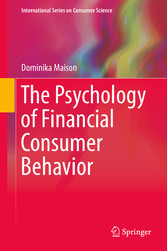Suchen und Finden
Service

The Psychology of Financial Consumer Behavior
Dominika Maison
Verlag Springer-Verlag, 2019
ISBN 9783030105709 , 242 Seiten
Format PDF, OL
Kopierschutz Wasserzeichen
Geräte
Preface
6
Contents
9
About the Author
12
Chapter 1: The Psychological Perspective in Financial Behaviour
13
1.1 Changes in Looking at the Human Being and Its Consequences for Understanding Financial Behaviour
13
1.1.1 From Full Rationality to Biased Decisions: Behavioural Economics
14
1.1.2 From Rational to Nonrational, from Controlled to Automatic Reactions: The Psychology of Social Cognition
16
1.2 Individual Differences in Financial Behaviour
19
1.2.1 Psychological Non-specific Traits: Big Five
20
1.2.2 Psychological Non-specific Traits: Individual Traits Outside of the Big Five
25
1.2.3 Psychological Specific Traits (connected to finances)
34
1.3 Financial Typology: From Banking Leaders to the Financially Withdrawn
37
References
51
Chapter 2: Richness: How Much Money Do We Have and How Do We Think About It?
62
2.1 Three Dimensions of Financial Situation: Objective (Income), Subjective (Perception), and Relative (Effect of Social Comparisons)
62
2.2 The Power of Perception: Financial Optimists Versus Pessimists
65
2.3 Does Money Bring Happiness?
67
2.4 Financial Situation Versus Satisfaction with Life: Own Study
70
2.5 The Psychological Background of Financial Satisfaction: Which Psychological Factors Influence the Perception of Financial Satisfaction?
73
2.6 Through Money to Happiness or Through Happiness to Money?
78
References
80
Chapter 3: Spending Money: Pleasure or Pain? Why Some People Spend Money Easily While Others Have a Problem with It?
84
3.1 Functional Versus Emotional Role of Money
84
3.2 Subjective Value of Money and Prices
86
3.3 Mental and Emotional Accounting
88
3.3.1 Mental Accounting: The Drawers and Compartments of the Brain
88
3.3.2 Emotional Accounting: The Meaning of the Source of Money
89
3.4 Psychological Factors Influencing Spending: Non-specific Factors (Not Connected to Financial Behaviour)
92
3.5 Psychological Factors Influencing Spending: Specific Factors (Connected to Financial Behaviour)
95
3.6 Money Spending Style (Own Concept): Individual Factors Determining Spending Differences
97
3.6.1 Money Spending Style Versus Emotions and Satisfaction with Life and Finances
100
3.6.2 Money Spending Style and Non-specific Psychological Variables
101
3.6.3 Money Spending Style and Materialism
103
3.6.4 Qualitative Exploration of MSS
103
High Control of Spending: Thrifty Spending Versus Belt Tightening.
104
Low Control of Spending: Happy Spending Versus Spendthrift
106
Attitudes Towards Money in Persons with Different Money Spending Styles
108
References
111
Chapter 4: Saving and Investing
115
4.1 Why Is Saving Important?
115
4.2 Why Do People Save: Different Approaches to Saving Mechanisms
118
4.2.1 LCH: Life-Cycle Hypothesis
118
4.2.2 The Behavioural Life-Cycle Hypothesis
119
4.2.3 The Typology of Saving According to George Katona
121
4.3 Saving Strategies
121
4.4 Saving Motives and Goals: Why Do People Save and What Do People Save for?
123
4.5 Individual Determinants of Saving
127
4.6 Having Savings and the Amount of Savings Held (Own Study)
131
4.7 Investing: A Higher Level of Saving
136
4.8 Cultural Determinants of Saving and Investing
142
References
146
Chapter 5: Loan: Needed or Wanted?
152
5.1 Indebtedness and Everyday Functioning
152
5.2 External Factors Determining Borrowing
155
5.3 Knowledge, Skills, and Attitudes as the Determinants of Consumer Debt
157
5.4 Impact of Psychological Non-specific (Not Related to Finances) Characteristics on Taking on Debt and Paying It Off
162
5.5 Impact of Psychological Characteristics (Specific, Connected to Finances) on Taking on Debt and Paying It Off
165
5.6 Borrowing Money and Saving
168
5.7 Segmentation of Debtors: Own Study
173
5.7.1 Segment 1: Forgetful (24%)
176
5.7.2 Segment 2: Indebted for Others (24%)
178
5.7.3 Segment 3: Carefree (19%)
180
5.7.4 Segment 4: Lost in Finances (18%)
181
5.7.5 Segment 5: Avoiders (12%)
183
5.8 Individual Predictors of Debt and Debt Repayment
185
References
188
Chapter 6: Banking, Unbanking, and New Banking
193
6.1 Why Do Some People Not Have Bank Accounts?
193
6.1.1 How to Increase the Level of Banking – A Diagnosis of Barriers to Having a Bank Account (Own Study)
197
6.2 Love for Cash: Psychological Barriers to Cashless Transactions
202
6.3 Levels of Banking: From Cash to Full Cashless Societies
208
References
214
Appendix 1: Demographic Structure of Sample of FinBehTrack 2016
217
Appendix 2: FinBehTrack 2016 – Questionnaire
218
Part 1. Life Satisfaction (LS)
218
Part 2. Approach to Life (AL)
219
Part 4. Banking Products (BP)
223
Part 5. Saving and Investing (S)
224
Part 6. Borrowing – Loans and Credits (LC)
225
Part 7. Payment Cards (PC)
226
Part 8. New Technologies (NT)
227
Part 10. Insurance
228
Part 12. Money Spending Style (MSS)
229
Part 13. Saving and Investing (SAV)
230
Part 14. Love for Cash (LfC)
232
Part 15. Attitude to Money and Material Possessions (MAT)
233
Part 19. Financial Situation (FS)
234
Index
237
Shop


